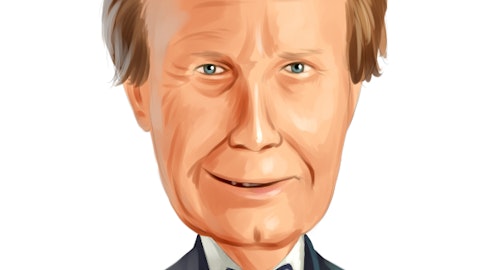Innovative Solutions and Support, Inc. (NASDAQ:ISSC) Q1 2024 Earnings Call Transcript February 15, 2024
Innovative Solutions and Support, Inc. isn’t one of the 30 most popular stocks among hedge funds at the end of the third quarter (see the details here).
Operator: Good day, and welcome to the Innovative Solutions & Support First Quarter Fiscal 2024 Financial Results Conference Call. All participants will be in listen only mode. [Operator Instructions]. Please note, this event is being recorded. I would now like to turn the conference over to Dr. Shahram Askarpour, Chief Executive Officer and a member of the Board of Directors. Please go ahead.
Shahram Askarpour: Good morning. This is Shahram Askarpour, Chief Executive Officer of Innovative Solutions & Support. Welcome to our conference call to discuss our performance for the first quarter of fiscal 2024, current business conditions and outlook for the coming year. Joining me is, Rell Winand, our CFO. Before we begin, I’d like Rell to provide a cautionary statement about forward-looking information.
Rell Winand: Thank you, Shahram, and good morning, everyone. I would remind our listeners that certain statements made in matters discussed in the conference call today, including those about new products and operational and financial results for future periods contain forward-looking information. These forward-looking statements are subject to assumptions, risks and uncertainties that could cause actual results to differ materially, either better or worse from those discussed. I specifically call our listeners’ attention to our disclaimer regarding forward-looking statements in our Form 10-Q filed yesterday, which disclaimer, along with our public filings represented describe these assumptions, risks and uncertainties. I also remind our listeners that plans and expectations we expressed speak only as of today’s date, and listeners should not place undue reliance on any forward-looking statements. Now I’ll turn the call back to Shahram.
Shahram Askarpour: Thank you, Rell. I will begin today with remarks on our performance in the first quarter of fiscal 2024, followed by comments on our long-term growth plan and strategy, including the ongoing integration of the products acquired and licensed from Honeywell. I will then turn the call back to Rell, who will take us through the financials. For the quarter, revenues were up 43% with net income increasing 51% from a year ago. This increase has us on pace to meet our goal of increasing revenues by 40% of the organic fiscal 2023 revenues due to the addition of the Honeywell product lines. At this time, we expect full integration of the Honeywell product line to be nearly completed this fiscal year. First quarter results were in line with the expectations expressed previously.
That aside, results once again demonstrate the strength of our strategy, addressing the diversified military, commercial air transport and business aviation markets. Although, we have experienced an anticipated slowdown in commercial air transport and cargo markets, we have counted the slowdown by renewed strength in the military markets. With the addition of the Honeywell product lines, an increasing proportion of our revenues are now recurring in nature, including our OEM production contracts with Boeing, Textron and Pilatus. These production contracts provide a growing pace of reliable revenue that generates strong margins and strong cash flow. Margins this quarter were 59.3%, an improvement from the first quarter of fiscal year 2023. Cash flow was strong in the quarter, enabling us to reduce our debt position by nearly $9 million in the quarter.
We expect the credit line balance will continue to be reduced throughout the fiscal year, barring another acquisition. We also maintained our commitment to research and development as evidenced by the increase in R&D expense. This increase includes our efforts to develop new products and to add new capabilities to existing technologies and to integrate the acquired Honeywell product lines. This work is directed at our long-term vision where we believe there is increasing demand for technologies that reduce pilot workload and would ultimately lead to single pilot flights in air transport aircraft. Our funded R&D represents a contract with Pilatus to develop a second-generation UMS, a product we expect to be extended into additional airframes.
This is further evidence of our strong value proposition and the confidence we gained with our customers. Part of the increase in selling, general and administration expense in the quarter was the increase in staffing our sales organization. While we have always enjoyed a good reputation internationally, the Honeywell acquisition provided us an experienced, established global sales footprint, which we believe opens large new markets, not only for the Honeywell products but also for our legacy products. Many of the hundreds of customers that came along with the new products are new to IS&S, representing another new market, we believe, offers great promise. Quickly updating the status of the Honeywell product line, all the test equipment and inventory is arriving, and the Honeywell training associated with the products have been completed.

We are now processing maintenance and repair of radios in-house Meanwhile, the transfer of the IRU inventory is progressing with the handoff of these products expected to occur by the end of the current quarter. We expect the top and bottom line benefit of these new products to begin to gradually ramp up. As I mentioned, we have increased our sales and marketing investment to support the sales of these products. As we begin to develop strategies to fully recognize the inherent synergies and potential of these products, we believe that we will realize growth from such synergies and strategies. For these reasons, we will continue to opportunistically evaluate and make plans to execute additional complementary acquisitions should appropriate opportunities arise.
Our goal now is to leverage this momentum to sustain this growth over both near and longer term organically and through additional acquisitions. Finally, I want to update you on our ongoing search for a permanent CFO. We have retained an executive search firm, and we have already completed a round of interviews that yielded several highly qualified candidates. Thank you for your time and interest, and we look forward to updating you in the upcoming quarter. I will turn the call over to Rell for a closer look at numbers.
Rell Winand: Thank you, Shahram, and thank you all for joining today. Let me quickly review the highlights of our financial results for the first quarter of fiscal 2024. Revenue in the first quarter was up 43% due to the contribution of customer service sales of the product lines acquired and licensed from Honeywell. First quarter gross margin was 59.3%, up from a year ago but down slightly on a sequential basis in the fourth quarter, primarily due to the impact of increased material costs and overhead absorption and customer service. In the first quarter of fiscal 2024 research and development expense was approximately $900,000 or 9.7% of net sales. Note that research and development expenses have increased in absolute terms, but has decreased as a percentage of net sales.
When the current engineering development contract is completed, the engineers working on that development contract will return to research and development efforts. This will result in increased research and development expense in subsequent quarters. First quarter fiscal 2024 selling, general and administrative expenses increased from a year ago, primarily due to an increase in sales and marketing expense, the quarterly amortization of the intangible asset associated with the Honeywell product line license and acquisition and professional and consulting fees. I will note that we sold the King Air airplane in the quarter for $2.3 million and the resulting gain on the sale was used to reduce total selling, general and administrative expenses.
The gain was approximately $162,000. Interest income was down in the quarter, consistent with our new P&C bank line of credit account that uses daily cash balance to reduce debt at the end of every day. Interest expense in the quarter was up from zero a year ago, although we do not expect interest expense — although we do expect interest expense to trend down, not only as interest rates are anticipated to for, but also because we’re planning to use the majority of our cash flow to pay down debt. Taxes are being accrued at a rate of 12.8% versus the statutory rate of 21%, reflecting increased state tax expense due to the gain on the sale of the King Air airplane. Net income for the quarter was $1.1 million or $0.06 per share, up from $700,000 or $0.04 per share in the year ago quarter.
New orders in the quarter were approximately $10.4 million, so that we ended the quarter with a backlog of approximately $14.6 million. As always, quarterly orders can vary due to a number of factors and are not meant to provide an indicator of future revenues. Virtually all the Honeywell revenues are from intra-quarter book and ship orders that are not included in the backlog. For the first quarter of fiscal 2024, the company generated $4.2 million of cash flow from operations. The company’s debt on December 31, 2023, was $10.6 million, down $8.9 million from $19.5 million as of September 30, 2023. As a result of the daily cash balance sweep component of the company’s line of credit is required to be classified as a current liability on the balance sheet.
During the three months ended December 31, 2023, cash also benefited from the sale of our King Are aircraft for $2.3 million. With that, operator, we’re ready for questions.
See also 30 Highest-Grossing Media Franchises of All Time and 30 Unhappiest Countries In The World.
Q&A Session
Follow Innovative Solutions & Support Inc (NASDAQ:ISSC)
Follow Innovative Solutions & Support Inc (NASDAQ:ISSC)
Operator: We will now begin the question-and-answer session. [Operator Instructions]. At this time, we will pause momentarily to assemble our roster. The first question comes from Theodore O’Neill with Litchfield Hills Research. Please go ahead.
Theodore O’Neill : Thank you very much. I just have two questions. The first one is about on the sales side. The reduced shipments of displays for the retrofit in the commercial market, do you have a view on if and when that would might change? And what would be the driver for it?
Shahram Askarpour: It’s — some of it is seasonal. Some of it is — we’re introducing a new product line in that market, which should begin — we should begin or finish its certification this quarter, and we should begin to see some revenues from next quarter. But we’ve anticipated that on the cargo market, as these airplanes get older-and-older, and that eventually will see a slowdown in these upgrades, which — and because of that, we developed some additional products and put a larger emphasis on our military efforts, which were kind of not — in some ways, there was another priority before we were focusing on the overall product lines. So we’ve put an emphasis over the last couple of years on the military side of things, we got — because the OEM, new OEM contract from Boeing on the T-7 trainer, and we continue to work on a lot of new opportunities that are coming, both OEM as well as the aftermarket and the military side.
So we’re looking at that over the next few years to essentially be a larger driver than the air transport side. On the air transport side, what we’re doing is that we’re offering a lot of upgrades, which, as we talked before, leads to more automations within the cockpit and eventually to a single pilot operation for these Part 25 airplanes. The single pilot operation is the longer-term strategy. Meanwhile, we will be seeing some revenue from some of these additional features that we are offering on these cockpits. But the big-ticket items of completely retrofitting a cockpit of a 5767 aircraft that has slowed down. And like I said, we had anticipated.
Theodore O’Neill : Okay. Yes, makes sense. And on the SG&A expense, the amortization of the customer relationships that was in the SG&A in the quarter, is it a significant part of the increase? And does it continue on for many more quarters?
Rell Winand: Yes. It goes, it’s a 10-year amortization. It’s about $268,000 quarterly. It will continue, obviously. So that’s a big driver of the increase. And of course, as Shahram mentioned, we’ve hired sales additional salespeople. So that’s a big piece of it, too.
Theodore O’Neill : Okay. Thanks very much.
Shahram Askarpour: Generally, our auditing fees and legal fees have been higher…
Rell Winand: Quarter-to-quarter, they were they were fine.
Shahram Askarpour: Of the acquisition
Rell Winand: Yes. Boeing staff, yes.
Theodore O’Neill : Okay. Thanks guys.
Rell Winand: Thanks.
Operator: The next question comes from Andrew Rem with Odinson Partners. Please go ahead.
Andrew Rem : Morning, gentlemen. I just had a question to start with. How should we think about gross margins within the customer service segment?
Rell Winand: Growth, in what way? Typically, it’s been higher.
Andrew Rem : Right. Fourth quarter rate, 68.5% and in fiscal ’23, year-to-date and it had been running 71%. And so I don’t know if — I mean, you mentioned some under-absorption, but you had much higher revenue this quarter than first quarter, second quarter or third quarter of last year?
Rell Winand: Right. So it’s — go ahead. Sorry.
Andrew Rem : No. I’m just trying to understand nuances.
Rell Winand: Yes. Well, you got.
Shahram Askarpour: Andrew, can you repeat that, please? You said we had gross margins of 71%?
Andrew Rem : Well, the year-to-date through the first three quarters of fiscal three was running 70%, 71%. Then fourth quarter was 68.5% and then now you impact 59%. So I’m just trying to understand the nuance what moves the gross margin around and this quarter’s revenue in customer service was higher than the revenue run rate in the first three quarters of last year?
Rell Winand: Right. But the customer service revenue is a bigger piece of the whole. So it’s going to end up with more overhead absorption into it. As well as we’ve seen material, as you can understand, has cost of material, the price has increased. So we have to keep increasing our standards. So it’s — and it’s mix depends on what you’re re-preparing. But yes, it is down from previous. Well, like I said, your — half of your sales almost is customer service. So that’s going to get a bigger piece of everything, if that makes any sense to you.
Andrew Rem : Okay. And then on the cost material side, how long does it take you to kind of get some price recovery there?
Rell Winand: I get somewhat. Can you repeat that? I missed that.
Andrew Rem : On the cost of materials, how long does it take you to get this recovery?
Rell Winand: It doesn’t take — on the customer service side, not too much because a lot of what we do other than warranty is cost up. So as we’ve been increasing those, it’s going to flow through to the — what we charge the customer.


